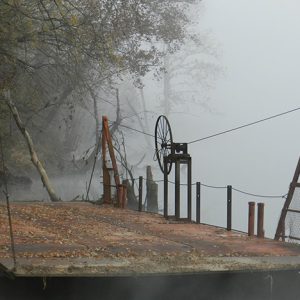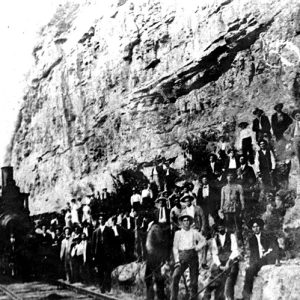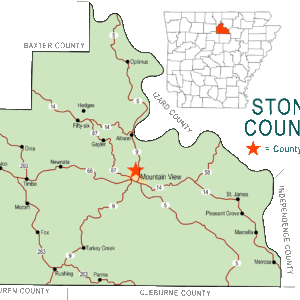calsfoundation@cals.org
Marcella (Stone County)
Marcella is located on Highway 14 about halfway between Batesville (Independence County) and Mountain View (Stone County). Marcella lies across the White River from the historic community of O’Neal (Independence County). The community of Marcella has its origins in a settlement called Hess Town, one of the first settlements in the Missouri Territory.
Samuel and Sarah Hess married in 1810 in Kentucky (some sources say Tennessee). Following the birth of their first child, they traversed the wilderness trails to the White River bottoms near Polk (a.k.a. Poke) Bayou in 1812, in the newly created Missouri Territory. They were among the first to settle across the White River in an area eventually called Hess Town. Only a few scattered members of the Osage tribe lived in the area at the time of the Hesses’ arrival. The Hess family farmed the alluvial White River bottomland, growing corn and cotton. The corn was also utilized to make moonshine liquor, a lucrative business in the hills of Arkansas, and Sam Hess quickly gained a reputation of having the best moonshine in the county. Sam’s brother Solomon Hess and his family arrived around 1814. Sam and Solomon Hess appear on the 1816 tax records for Lawrence County in Arkansas Territory. Solomon Hess was as knowledgeable as his brother on methods of distillation. Besides a still, the brothers constructed a cotton gin and sawmill, adding to their farming endeavors. Sam and Solomon Hess became prominent and wealthy farmers of the region.
After building grist mills for his booming business, Sam Hess died suddenly in 1837 at age forty-five, leaving Sarah and ten children (ages six to twenty-seven) to carry on the operations with the help of Solomon and his family. Across the river from Hess Town lay O’Neal, where John O’Neal and his family settled in 1830. Following Solomon’s death in 1841, one of his sons, William Hess, built a ferry connecting Hess Town and O’Neal. The ferry became known as the Hess Ferry. Hess Town was often referred to as Hess Ferry by travelers. William Hess’s son, Thomas Marion Hess, assisted his father with the ferry.
Many credit Thomas Marion Hess as the founder of what would become Marcella, since he did much to promote the Hess enterprises in Hess Town and O’Neal following his father’s death in September 1861 at age forty-eight. He was aided by fellow family members, especially his brother, Henry Binks Hess. By the time of the war, Charles Grigsby of O’Neal owned and operated a rival ferry about a mile downstream from Hess Town. Many referred to it as the Grigsby Ferry.
The Hess and Grigsby ferries played crucial roles in the Civil War in Independence County. The Union was determined to gain control of the White River valley. It was particularly interested in Marcella and O’Neal because of the ferries and the area’s strategic location on the upper White River. Crossing the river using the Hess ferry was part of the alternative route for the military road to Mount Olive (Izard County), Yellville (Marion County), and on to Kansas City, Missouri. During the Skirmish at Knight’s Cove on June 19, 1862, the Grigsby ferry was purposely sunk by the Rebel commander William Chitwood in collusion with owner Charlie Grigsby. It was quickly rebuilt, however, by the Union forces under Lieutenant Ferdinand Hansen, partly to save face. The two ferries continued to be used throughout the war to transport troops to the Bethesda (Independence County) area, where the Skirmish at Waugh’s Farm took place on February 18, 1864.
After the war, Thomas Hess and his brother Binks Hess built stately mansions. The Thomas M. Hess House was built in 1868 and is the oldest known central-hall–plan house in Stone County. Built about 1871, the Binks Hess House and barn also still stand in the twenty-first century. The barn is believed to be the oldest in Stone County and one of the first to use sawn lumber in its construction. A house built by William Hess’s grandson, Thomas Ecliastine “Turk” Hess, was built in 1900; other buildings on the Turk Hess property include a barn, a stone cellar, and a log corn crib that was originally built as a schoolhouse. All three houses are on the National Register of Historic Places.
Marcella was formally established in 1880 with David Miller Hill appointed as postmaster, seven years after Hess Town became part of Stone County. David Hill and two brothers, William and Baldwin Hill, owned and ran a dry-goods store in Marcella, which included the post office. An earlier post office had been established at Wallace Creek in 1849, with William Hess appointed the first postmaster. It closed in 1866, and those who lived in Hess Town got their mail at St. James (Stone County) until the Marcella post office opened in 1880. The origin of the name Marcella, submitted by one of the Hill brothers, is unknown but is said to have been suggested by Thomas Hess because he liked the name.
The Marcella and O’Neal areas prospered in the early 1900s. By 1902, railroads were replacing steamboats and other means of transport and trade. The Missouri and Kansas City Railroad followed the east bank of the White River across from Marcella. The coming of the railroad and its need for raw materials spurred Marcella’s growth, and it reached a population of 300 in the early 1900s.
A country school was started on the Turk Hess farm in the early 1900s. In 1949, under Arkansas Initiated Act No. 1 of 1948, a new district was formed, the Stone County School District No. 1, which included all school districts in the county other than Mountain View. The newly formed school centers, with a county superintendent as overseer, were Rural Special at Fox (Stone County), Timbo (Stone County), Fifty-Six (Stone County), and Pleasant Grove (Stone County). The old school at Pleasant Grove, which is still standing, also served the children of Marcella until consolidation with the Mountain View School System around 1970.
The building of a bridge over the White River at Batesville in 1927–1928 contributed to the decline of Marcella and O’Neal, as ferries were no longer important in trade and commerce in the White River valley and surrounding hills.
At its peak, Marcella was a booming hill community with a port and ferry, cotton gins and mills, sawmills, warehouses, and wholesale and retail businesses, in addition to the rich alluvial farmland in the White River bottoms. The lucrative trade in illegal moonshine also contributed to the economy.
Marcella’s rich history has led to the placing of several landmarks on the National Register of Historic Places for Stone County. Besides the three Hess properties, National Register properties include the Jessie Abernathy House, the H. J. Doughtery House, the Marcella Church and School, the Owen Martin House, and the Taylor-Stokes House.
For additional information:
Huddleston, Duane, Sammie Cantrell Rose, and Pat Taylor Wood. Steamboats and Ferries on the White River: A Heritage Revisited. New ed. Fayetteville: University of Arkansas Press, 1998.
Lankford, George. “Marcella and Its Founders.” Independence County Chronicle 37 (October 1995–January 1996): 3–47.
Mobley, Freeman K. Making Sense of the Civil War in Batesville–Jacksonport and Northeast Arkansas. Batesville, AR: Frank K. Mobley, 2005.
Phillips, Freda Cruse. Places of Our People: Ozarks, White River Valley. Kearney, NE: Morris Publishing, 2011.
Kenneth Rorie
Van Buren, Arkansas
 Binks Hess Barn
Binks Hess Barn  Hess/O'Neal Ferry
Hess/O'Neal Ferry  Iron Mountain Railway Crew
Iron Mountain Railway Crew  Penters Bluff
Penters Bluff  Stone County Map
Stone County Map 




David Miller Hill was my maternal grandmother’s father, thus my great-grandfather. The Hill brothers and their families eventually moved to Moody, Texas, and his widow (my great-grandmother) eventually moved to Highland Park in Dallas. I was born in Dallas. Thank you for this piece of family history.